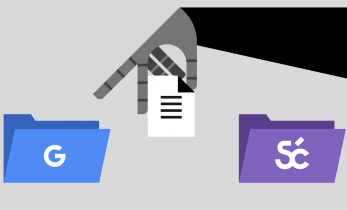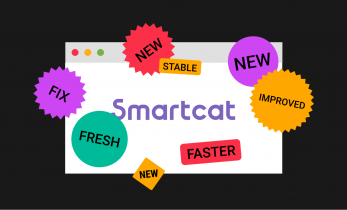Greater than 5 minutes, my friend!
Why we have created the Fair Trade Translation service What you won’t read in the press
The last 2 months I have not published anything on the Open Mic – too busy testing the updated Fair Trade Translation service. I was wondering if I should write about this new platform on the Open Mic because, as one of its creators, I have a conflict of interest. Still, I decided to do it because I want to give some insight into why we created the Fair Trade Translation service, why it is free, and why it supports, for now, only professionals translating from English into European languages. Things you won’t read about in the press. But most importantly, I decided to do it because it is service that I believe strongly it can help many professional translators.
What Computer Aided Translation (CAT) tools don’t do
While working as a freelance consultant for translation technology companies, I always wondered why no CAT was giving translators the same kind of warnings my car was giving me — “fasten your seat belt” or “you’re speeding”; or why no CAT was acting as my car, switching on the wipers when it stared to rain and switching on the lights when it got too dark. All CATs allow translators to start working on jobs even when they are not fit for them. When your own Translation Memory (TM) gives you almost no fuzzy matches and when the terms in your termbase are not present in the document you’re doing a word count on, you should at least get a warning. You may still ignore the warning of course, but… CATs give no warning.
Your CAT is collecting data about you; so it should know what you’re good at and what kind of translation jobs you struggle with and take lots of time to complete. When you use the same word price for a job in your comfort zone as for a job outside your comfort zone, you are taking risk. When you receive jobs in which low fuzzies and untranslated segments were replaced by machine translations of unknown quality, you are often asked to lower your price, which means that you are asked to take even more risk. When working on low quality machine translation outputs, your CAT should be in full alert mode; but it is silent.
Daniel Marcu, one of the scientists who created the first commercial statistical MT algorithms, and I have worked together since 2004. We were the first to use MT successfully in a localization setting and were initially enamored with the technology and its potential. But recently, we became increasingly apprehensive about how the technology is used. As any disruptive technology that is poorly understood and deployed without appropriate safeguards, MT is creating shadow work. When professional translators spend time fixing low-quality machine translated outputs while being paid lower post-editing prices, something has to give: sometimes it is the quality of the outcome; sometimes it is the relationship between the service provider and the buyer; and sometimes it is the bottled up feeling that the transaction was not fair. As we internalized these developments, we found it frustrating that everybody was complaining about it, but nobody was really willing to address the issue.
From a market pain to a product release
So we did it ourselves. We created initially a service that made it visible when a machine translated sentence was crap. If we want to stop customers ask us to lower our price because MT did already part of the job, we should be able to show them a neutral, expert report. This is exactly what our initial, beta product was doing. We started testing the beta release in October 2015.
To our delight, our sentence level quality predictor was sufficiently reliable. OK, sometimes we don’t get it right, when a medieval text or poetry is submitted, for instance, or on complex marketing or religious texts… More importantly though, our beta users started to trust us and ask for more features: “it would be nice if you could extract terminology and get that translated into context”, or “it would be great if you could analyze the source text and tell me how hard it would be for me to translate it”, or “how helpful a memory translation tool could be”… We also got a lot of “complaints” from users regretting we did not support their language pair.
So during the last six months, we worked on source text analysis. We used and improved existing NLP technologies that are not embedded in any CAT today to quickly give translators an insight into the source text they contemplate translating. We also added support for additional European target languages, beyond the five we supported in the beta release.
We currently support only translation analyses out of English because the technology we use is not available for most other languages and because adding other source languages takes time. We plan to add other language directions as the demand for those directions grows.
We know we only support a couple of file formats, but I guess most translators know CloudConvert. If you don’t know this, check it.
While we were testing our service, we noticed our GUI was a bit messy. Translators testing our new features got lost. So we also simplified the user interface. Less is more. And then we discovered we needed to add some text to explain what the graphs are saying.
Some people wonder why this service is free. There must be a catch. Well, there is one. It is free because we are driven by a compelling social mission — to create technologies that promote the adoption of fair trade principles in labor markets, such as Language Services, in which Artificial Intelligence-based products, such as MT, introduce friction; and it is free because we value usage more than revenues. Our goal is to create technology services that are used by as many translators as possible. Our thesis is that, if we succeed at building something very useful, we will also succeed in convincing our membership to eventually compensate us fairly for our services.
Thanks to all people who helped us
Fair Trade Translation would have not reached this stage without the feedback of many translators who found the time to continuously put our technology to the test and had the patience to wait to see their requests become reality. We THANK YOU ALL!
I hope this blog, in which I explained why we created our service but not how our service works, made you curious and that you’ll test Fair Trade Translation. If you like it, we hope it is easy enough for you to use it on every job you contemplate taking. If you have feedback, just reach out to Daniel or me.
If you would like to receive more info about our service, please sign up here.





That’s a comprehensive explanation Gert!
I’ve loved the service from that I was pointed to it and I can’t wait to test it in full in my language pair (the test documents were already impressive!).
Thanks Pieter. Thanks to all the translators suggesting improvements and new features, we have not yet run out of fuel. But it is a real challenge to keep things simple when trying to reveal the complexity of translation.
This is fascinating! (I’m channeling Spock.) Do you have some journal articles about NLP analysis of machine translation that you could suggest? I did a Google and found this first: The Stanford NLP Group
link to nlp.stanford.edu
Not knowing anything about this, I imagine that to analyze the quality of a machine translation you would be looking at the output sentence by sentence (more than word by word). Perhaps you would look at word location in the sentence. For example, German and Japanese have the verb at the very end of the sentence, so you would check if the target output (into German or Japanese) has the verb at the end. And then perhaps the verb of a sentence becomes the hub of a wheel, where the spokes of the wheel connect the other words in the sentence back to the verb. Then you might look at subject-verb pairs, do analysis like Linguee.com and see through a Google search if the subject-verb occurrences are frequent or pass a certain threshold of being commonly used. Wow.Thats a lot of work. I need a nap now, just thinking about it!
There’s a lot going on in the NLP world, especially now that traditional machine learning is challenged by neural network technologies. Daniel is with his two feet in both worlds; I’m happy I can understand the innovations, so I’m following groups on LinkedIn like: Natural Language Processing People, Machine Learning Connection, Machine Translation, Automated Language Translation… But a lot of innovations, often more actionable, are being reported by all the companies building tools for translators; for this I subscribed to the Tool Box Journal from Jost Zetzsche, Common Sense Advisory, … If we want, we can read all day and all days. But sometimes we also have to work a little 😉
Thank you so much for sharing, Gert! Good luck with FTT, I hope it’ll catch on and bring a lot of value to the community. What you’re doing with analyzing MT output is really really smart and I hope other companies that build tools for translators will follow your example.
Can I quote you on that, Dmitry?
Sure, Gert. Absolutely!